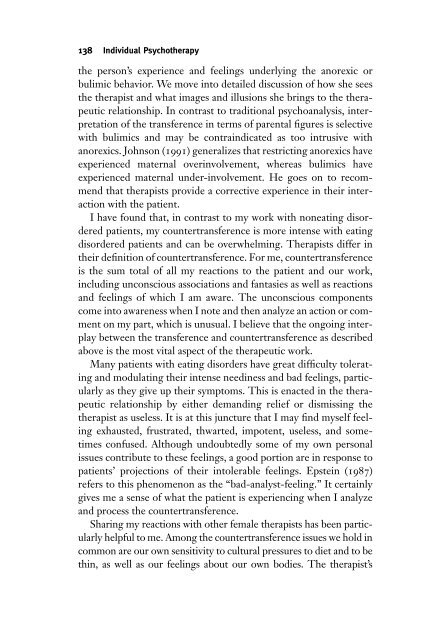Eating Disorders - fieldi
Eating Disorders - fieldi
Eating Disorders - fieldi
Create successful ePaper yourself
Turn your PDF publications into a flip-book with our unique Google optimized e-Paper software.
138 Individual Psychotherapy<br />
the person’s experience and feelings underlying the anorexic or<br />
bulimic behavior. We move into detailed discussion of how she sees<br />
the therapist and what images and illusions she brings to the therapeutic<br />
relationship. In contrast to traditional psychoanalysis, interpretation<br />
of the transference in terms of parental figures is selective<br />
with bulimics and may be contraindicated as too intrusive with<br />
anorexics. Johnson (1991) generalizes that restricting anorexics have<br />
experienced maternal overinvolvement, whereas bulimics have<br />
experienced maternal under-involvement. He goes on to recommend<br />
that therapists provide a corrective experience in their interaction<br />
with the patient.<br />
I have found that, in contrast to my work with noneating disordered<br />
patients, my countertransference is more intense with eating<br />
disordered patients and can be overwhelming. Therapists differ in<br />
their definition of countertransference. For me, countertransference<br />
is the sum total of all my reactions to the patient and our work,<br />
including unconscious associations and fantasies as well as reactions<br />
and feelings of which I am aware. The unconscious components<br />
come into awareness when I note and then analyze an action or comment<br />
on my part, which is unusual. I believe that the ongoing interplay<br />
between the transference and countertransference as described<br />
above is the most vital aspect of the therapeutic work.<br />
Many patients with eating disorders have great difficulty tolerating<br />
and modulating their intense neediness and bad feelings, particularly<br />
as they give up their symptoms. This is enacted in the therapeutic<br />
relationship by either demanding relief or dismissing the<br />
therapist as useless. It is at this juncture that I may find myself feeling<br />
exhausted, frustrated, thwarted, impotent, useless, and sometimes<br />
confused. Although undoubtedly some of my own personal<br />
issues contribute to these feelings, a good portion are in response to<br />
patients’ projections of their intolerable feelings. Epstein (1987)<br />
refers to this phenomenon as the “bad-analyst-feeling.” It certainly<br />
gives me a sense of what the patient is experiencing when I analyze<br />
and process the countertransference.<br />
Sharing my reactions with other female therapists has been particularly<br />
helpful to me. Among the countertransference issues we hold in<br />
common are our own sensitivity to cultural pressures to diet and to be<br />
thin, as well as our feelings about our own bodies. The therapist’s









